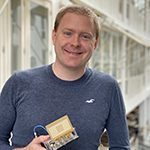A new comprehensive approach is needed in wireless research

Challenges in the industry are increasing as we move towards a digitalised society where everything needs to be connected. The competition for the rare earth metals required in our batteries is intensifying, the question of energy supply has come to the forefront, and there is also a significant equity aspect, with a large part of the world's population still lacking access to 5G mobile devices and the internet.
So, what is needed to build a reliable and digitalised society? Emil Björnson, a professor of wireless communication, believes that research needs to focus more on a holistic approach, from materials to usage.
”There is much talk about the digitalised society, but little about, for example, the lack of materials to meet the demand for batteries, particularly electric cars for everyone, or the equity aspect that many people in the world still lack mobile broadband and coverage,” he says.
Today, much of the focus is on making wireless connections faster, while the energy and material consumption in manufacturing and operation are of less importance. To shift perspectives, a competence centre for wireless communication is now being established at KTH, with key players including Ericsson, Saab, ABB, and RISE.
”We must put our foot down and say that the mobile networks are fast enough now, where there is coverage, and instead focus on making it more sustainable and robust. The equity aspect is also crucial in a holistic perspective, where we talk about the digital divide in the world and how to develop technology that works everywhere in the world.”

Future technology is modular
Emil Björnson believes that future technology is modular, where one can create optimised blocks that can be put together like Lego bricks into small and large mobile masts that can fit demanding urban cities and rural areas.
”Access to wireless technology also means that people in developing countries can catch up and gain access to both the internet and digitalisation. This, in turn, creates new development opportunities for women in these countries who gain access to the same technology,” he says.
Another crucial issue is access to and use of energy, where the current focus is on the electricity bill when the network is used. However, the focus should shift also to include the energy and material consumed in manufacturing.
”We can already see that the rare earth metals needed to make batteries are insufficient in society, and the same holds for other materials. Our centre focuses on making the materials in antennas more sustainable.”
Find ways to increase sustainability
He is convinced that more research is needed, and it`s essential to bring together different stakeholders to address the various challenges and find ways to increase sustainability. The first step in the new centre will be to initiate research, recruit new students and postdocs, and engage existing researchers in the centre.
"My main goal is to inspire other researchers by shedding light on these aspects. There is also an economic aspect where digitalisation is the new growth driver, and wireless connectivity is the backbone. When you look at the amount of information sent wirelessly, it increases by 30 to 40 per cent every year, and we also need to focus on sustainability and the proximity principle. Which mast and server should handle the wireless transfer and computations needed to deliver a specific service?” he says.
Related news
- Re-appointed IEEE Distinguished Lecturer
10 Feb 2025
- Humour - a key ingredient in software development
20 Aug 2024
